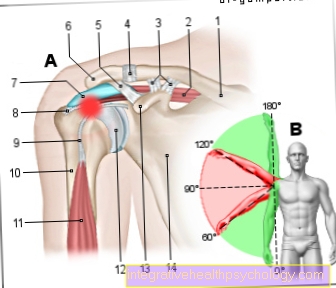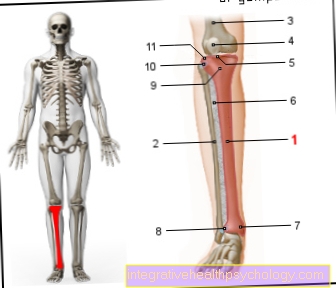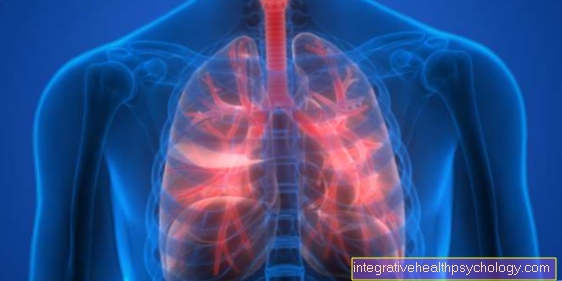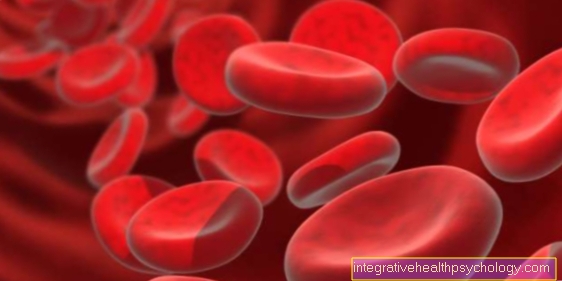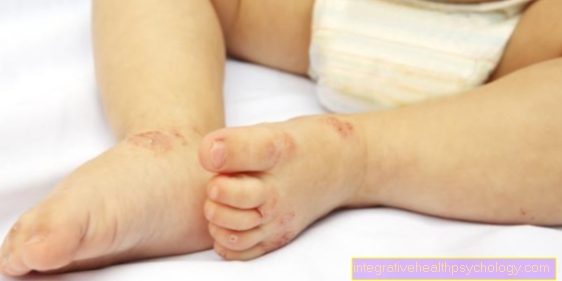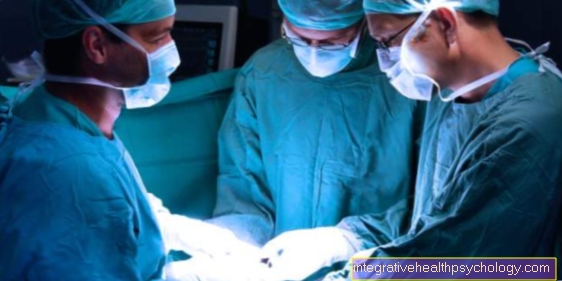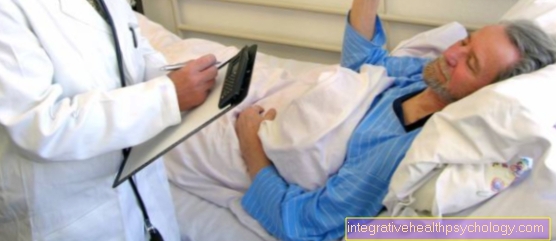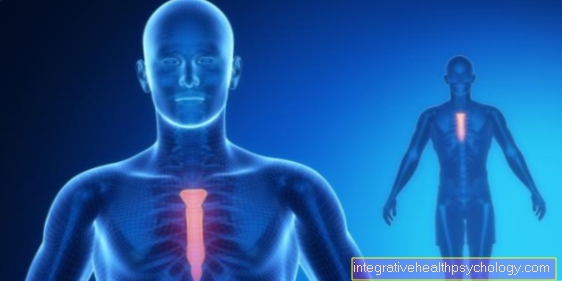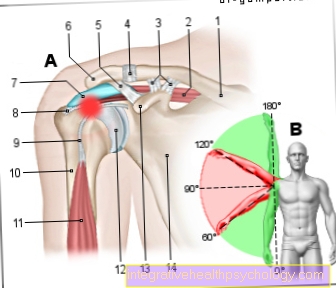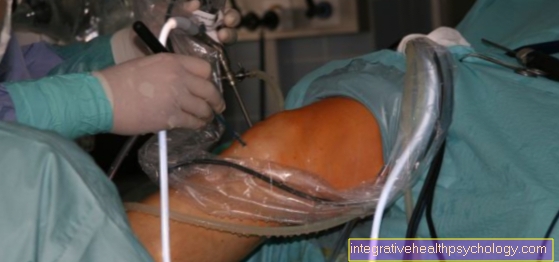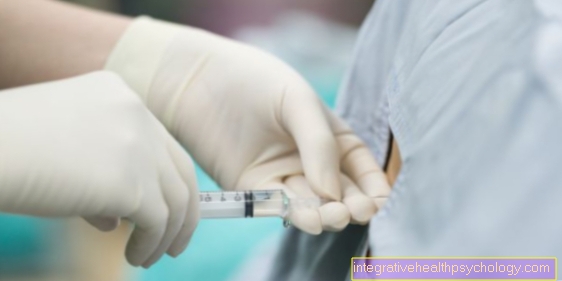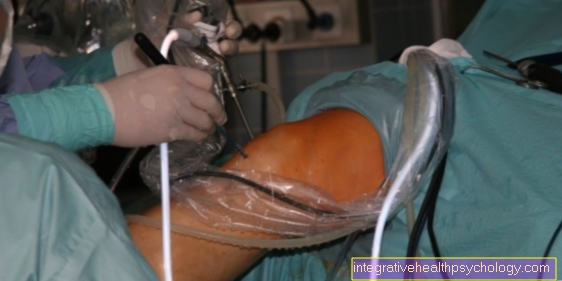Pain after a puncture
definition
Punctures describe the targeted stinging to obtain a sample, a so-called "puncture". Punctures are used in many places in medicine, for both diagnostic and therapeutic purposes. A puncture can be used to summarize simple blood withdrawals, artificial insemination and sampling of suspicious tissue.
Even if the puncture with thin needles is often only a minor physical intervention, there is always a risk of complications such as inflammation by damaging the skin barrier. Pain after a puncture is also not uncommon, as it is always an invasive procedure that is associated with a small injury to the tissue.

Causes of the pain
The pain that follows a puncture can have many causes. Since this is a small invasive procedure, minimal wound pain on the skin and the underlying tissues is not uncommon.
If an organ or bone is punctured, pain can also occur here due to a small tissue injury. However, these should subside again after a short time. In particular, bones or some abdominal organs are also surrounded by a capsule or a highly pain-sensitive shell, so that pain can arise during the puncture.
Apart from harmless wound pain, more severe pain can also arise as a result of complications.
This often involves injuries to smaller blood vessels or nerve arteries. If smaller blood vessels are damaged, the puncture site may bleed with swelling, redness and tenderness. Minor nerve damage can in turn be accompanied by electrifying, uncomfortable pain. Depending on the location of the puncture, large nerves can also be damaged. In most cases, the pain occurs during the puncture.
Inflammation is a rare complication. Pathogens can get under the skin via the small puncture channel and cause a reaction there that causes pain, redness and overheating. However, prior disinfection can prevent this complication in almost all cases.
Pain after a lumbar puncture
Pain after a lumbar puncture is a common complication. If desired, a local anesthetic can be performed before the beginning of the lumbar puncture or an anesthetic ointment can be applied to the skin.
The skin and muscle layers of the back are relatively thick, which is why the tissue injuries caused by the puncture needle are stronger. The needle used to perform the lumbar puncture is also thicker than many other puncture needles.
When entering the spinal canal, the sensitive meninges in particular can be painfully irritated. During the lumbar puncture, a small amount of the so-called "liquor" is removed. This is the fluid that surrounds the brain and supplies it with nutrients.
The puncture and removal of the fluid can lead to a negative pressure in the fluid spaces, which can manifest itself in headaches, nausea and vomiting. Drinking more before the lumbar puncture can reduce symptoms. The headache usually goes away on its own within a few days.
Find out more about the topic here: Lumbar puncture.
Pain after ICSI / IVF
Pain after ICSI (Intracytoplasmic sperm injection) or an IVF (In vitro fertilization) are not uncommon.
To perform this, the woman's ovaries are punctured after a drug preparation. This is done through the vagina with a thin puncture needle attached to the front of the ultrasound head. The puncture is carried out under sight with the ultrasound device in order to also safely hit the follicles in the ovary.
The follicular fluid is then sucked out to carry out fertilization. Here, too, there may be slight pain from the sting and minimal damage to the vagina and ovaries from the puncture needle.
If necessary, pain medication can be administered before the procedure. Stitches and pain in the abdomen or side can also result from suctioning off the follicular fluid. However, these are harmless and mostly entertaining.
Preparing the ovaries with medication to stimulate them can also make them more sensitive to pain and contribute to discomfort.
Find out more about the topic here: Desire for children.
Pain after a puncture of the thyroid gland
A thyroid puncture can be done to collect tissue samples from the organ. This is routinely done, especially for lumps and abnormal thyroid growth, to rule out malignant cells.
A puncture can also be performed on thyroid cysts to suck out the cyst fluid.
The thyroid gland is known as a “fine needle puncture” because, as the name suggests, it is a very thin needle that leaves only minor damage to the tissue. Pain after the puncture is very rare. This can be related to small bleeding that occurs more frequently when patients are given anticoagulant medication. The pain should subside on its own within a few days.
You might also be interested in: Thyroid disorders
Pain after a puncture of the chest
The breast is also punctured to obtain tissue samples for closer examination or to aspirate fluids from cysts. In the course of life, nodules can often develop in the breast, which cannot be precisely differentiated by an ultrasound or X-ray examination.
In order to identify potentially malignant tissue in time, various types of puncture can be performed on the breast.
The most important procedures are the "fine needle biopsy" and the "punch biopsy". Both are minimally invasive procedures, but to perform the punch biopsy, a small skin incision must be made beforehand under local anesthesia.
Either procedure can result in minimal temporary wound pain. With a punch biopsy, the risk of tissue infection is slightly increased but still very low. In doing so, attention should be paid to any redness and pain in the course.
For detailed information on the cause of a puncture, see Breast lump.
Pain after a puncture of the iliac crest
The puncture of the iliac crest is a more invasive measure than a fine needle puncture. It is performed under sterile conditions and a local anesthetic.
In the iliac crest there is bone marrow, which can be used to diagnose various blood disorders or hormone metabolism. During the puncture, so-called “punches” or “aspirations” can be taken.
Tightening the bone marrow through the needle during aspiration can be very painful for a brief moment during the procedure. Since the relatively thick needles cause a minor injury to the bone, pain that resembles a bruised bone often occurs even after the puncture.
If the puncture is performed incorrectly, surrounding tissue and organs, for example parts of the intestine or the bladder, can be injured, which can lead to complications and pain. Bleeding and infections can also occur as a result, but these are rare due to the sterile conditions during the puncture. These complications can be counteracted with a compression bandage.
Read more about bone marrow puncture Bone marrow donation and Iliac crest.
Pain after a knee puncture
The knee puncture can be done for a number of reasons. On the one hand, the puncture can also fulfill diagnostic purposes here by extracting joint fluids. Inflammation of the joint, bleeding or other diseases can be found here.
Knee puncture is also of great therapeutic importance. On the one hand, fluids such as blood or pus can be drained from the knee after injuries, operations or infections; on the other hand, medication can be applied directly via a puncture needle. In the context of various diseases, injections directly into the joint can be an important therapeutic measure.
However, the benefits of puncturing the inside of the joint must be weighed against the slight pain after the procedure, the potential damage to joint structures and the risk of infection after the puncture.
More information on the topic Knee puncture you'll find here.
Concomitant symptoms
After a puncture, various pains can occur locally at the site of the minor intervention. A slight wound pain must be differentiated from an inflammation, which is associated with clear reddening, overheating, restricted function and possibly purulent secretion at the puncture site.
The potential damage to neighboring organs and tissues can also be determined using accompanying symptoms. In the case of an iliac crest puncture, for example, mistakes can lead to perforations of the intestine, which are accompanied by their own specific symptoms.
This must be distinguished from symptoms that arise as a result of the body's reaction to the puncture. A typical example of this is the headache after the lumbar puncture. This can also be accompanied by neurological symptoms such as vomiting and dizziness.
diagnosis
Different types of pain must be distinguished based on the accompanying symptoms and circumstances.
A slight pain a few days after the puncture is usually harmless and can be attributed to the puncture needle.
In the case of unusual pain with specific accompanying symptoms, tests may need to be carried out to diagnose organ damage or other complications. For example, imaging methods can be used for this, such as ultrasound examination or computer tomography.
treatment
A slight pain a few days after the puncture rarely requires treatment. Larger punctures can be done under local anesthesia to relieve pain during the procedure and in the hours after it.
If the pain is too severe, it can also make sense to take a pain reliever. In most cases, pain medication from the NSAID group is sufficient for this, for example "Ibuprofen" or "Diclofenac".
Potential inflammations a few days after the puncture require more intensive diagnosis and treatment. Slight redness can be treated well with medicinal anti-inflammatory drugs or anti-inflammatory ointments. A larger infection may require antibiotics and extensive cleaning of the wound.
Duration of pain
The slight pain caused by the puncture usually subsides in a short time. Smaller biopsies can be painful for just a few hours. However, pain over 3-4 days should be classified as normal.
Larger punctures such as the lumbar puncture or the iliac crest puncture can occasionally cause longer pain. Here the pain may persist for over a week.
In the case of a lumbar puncture, this affects the pain as well as the potential neurological symptoms; in the case of an iliac crest puncture, the pain due to the injury to the bone can persist for a few weeks, similar to a bruised bone.
Complications, injuries to foreign tissues, or infections can prolong the pain indefinitely. It depends on the severity of the injury and the subsequent treatment.


